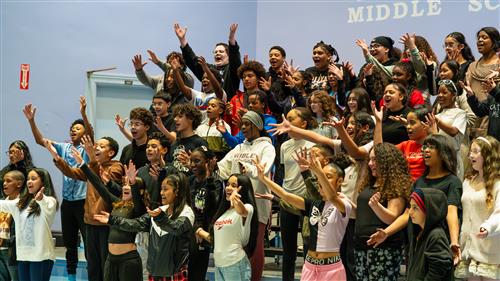- Providence's Turnaround Action Plan
- Excellence in Learning
Excellence in Learning
-

Excellence in Learning: Raising the Bar for Teaching, Learning, and Career Readiness
 What is the Excellence in Learning pillar?
What is the Excellence in Learning pillar?Every student enrolled in Providence schools will have access to a high-quality, equitable, data-driven learning environment that will provide them with the confidence to succeed academically and continue on to postsecondary education opportunities. There will be a heightened effort to ensure multilingual learners have the resources they need to learn at or above grade level.
Where We Started
Before the intervention, Providence Public School District faced several challenges in providing high-quality instruction across all schools. A significant issue was the lack of High-Quality Instructional Materials (HQIM), which meant that teachers did not have the resources needed to provide consistently rigorous and aligned instruction. This gap resulted in inconsistent instructional quality across the district, with some schools struggling to meet state standards.
Additionally, there was no coherent instructional model in place to guide teachers in delivering high-quality, standards-aligned lessons. Each school operated with its own approach to instruction, leading to disparities in student learning experiences. Teachers lacked a unified framework for instruction, which impacted the overall academic performance of students.
The district also lacked a systematic approach to instructional walkthroughs. Without regular and structured classroom observations, it was difficult for leaders and teachers to assess and improve teaching practices. This meant that professional development was not always targeted at the right areas, and instructional improvements were not being effectively monitored or supported.
Moreover, there was no consistent data-driven approach to track and improve instructional practices. The district did not have the tools or processes to regularly monitor student learning outcomes and make necessary adjustments to instructional practices. This lack of focus on evidence-based strategies left educators without clear feedback on how to improve student achievement in a targeted way.
Where We Are Now
Providence Public Schools has made big strides to ensure that all students are learning from high-quality materials, in classrooms led by strong teachers, with a clear focus on academic success. This work is guided by our belief that every child deserves excellent instruction every single day.
In classrooms across the district, students are now using high-quality instructional materials (HQIM) in English language arts, math, and science. To support this, teachers and school leaders are engaging in regular coaching, peer walkthroughs, and professional learning sessions. These efforts help ensure that the materials are being used effectively and consistently. Over time, the district has also implemented stronger systems to collect feedback, track student progress, and support continuous improvement.
To support the implementation of high quality curriculum, PPSD was able to partner with the Rhode Island Department of Education (RIDE) to secure over $4 million in grant funding from the Gates Foundation. The grant is being used to fund targeted instructional coaching for math teachers and expand the use of Canvas as the district learning management system (LMS).
Additionally, in the past, the district mostly relied on state tests once a year to check student progress. That changed in 2024 when the district began using Cycles of Inquiry in ELA and math—regular check-ins that help teachers adjust their instruction based on real-time data. The district also created a data dashboard that puts all assessment information in one place. This helps teachers and school leaders see how students are doing throughout the year, not just at the end.
Further, the district has developed and implemented a clear Multi-Tiered Systems of Support (MTSS) framework to help schools provide the right academic, behavioral, and emotional support for every student. Each school has its own MTSS team, and support services are better coordinated between departments. The district has also implemented a clear district-wide instructional coaching model to ensure that all coaches are working toward the same goals. Coaches help teachers grow their practice through regular feedback and support.
In Career and Technical Education (CTE), opportunities have grown significantly. In 2019, the district offered 18 CTE programs across 5 high schools. Today, we offer 28 CTE and pathway programs across 7 high schools, including new industry-aligned programs in fields like engineering, healthcare, and advanced manufacturing. Middle and elementary students are now getting early exposure to career pathways through electives like PLTW, SeaPerch, and the "Boats for Kids" program. Students who aren’t enrolled in CTE still benefit from hands-on career experiences like Electric Boat Application Day and summer job training with CCRI.
We’ve also introduced a new system to recognize different levels of CTE achievement—bronze, silver, and gold—based on how students meet and exceed career readiness goals. Every year in June, we host a "Career Signing Day" where employers present certificates to students who have received job offers. In 2024, 104 students were honored during this celebration.
The School Improvement team is ensuring that every school participates in a structured planning process each year, with a focus on the four domains of rapid school improvement: instruction, leadership, culture, and systems. These plans guide everything from classroom instruction to attendance strategies, especially in our most historically underserved schools.
What’s Next
Looking ahead, we’re aiming even higher. By 2026–27, our goal is for at least 69% of students to graduate with college credit, AP credit, or a CTE credential. We’ll continue expanding our programs and strengthening partnerships with industries like Electric Boat, Johnson Controls, LiUNA, and Providence Water. New after-school programs are also on the way to help students fast-track into high-wage, high-growth jobs such as pharmacy tech, machining, welding, and construction.
Every investment we make in curriculum, career pathways, and school improvement is designed with one goal in mind: to give every student the tools and opportunities they need to thrive.

